Asia is becoming a key player in global trade, offering many opportunities for businesses worldwide. Its fast-growing economies and changing market needs are crucial for international trade. Asia’s role in the global supply chain is getting stronger, thanks to its rich trade history and new markets.
Reports from the World Bank and the Asian Development Bank show Asia’s big impact on global trade. Countries like China and India are growing their economies, opening up big chances for trade. This article explores Asia’s trade scene, showing the many opportunities available.
The Growing Importance of Asia in Global Trade
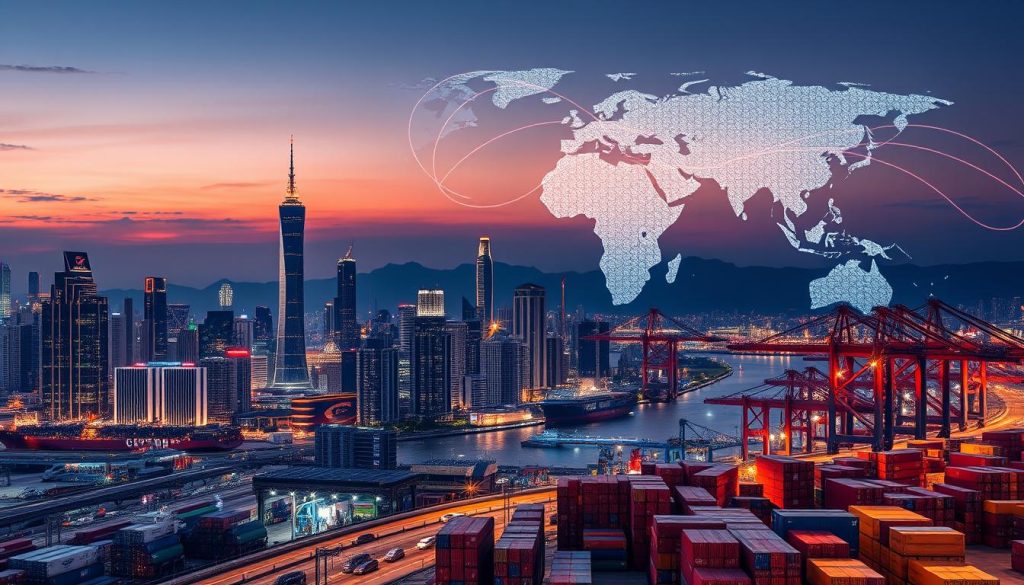
Asia’s role in global trade is becoming more important. Countries like China and India are growing fast. This makes them key players worldwide.
The rise of the middle class in these countries boosts consumer demand. This opens up new chances in many sectors.
Vietnam and Indonesia are also making their mark. They attract a lot of foreign investment and have big trade surpluses. Trade volumes have gone up, showing how global economies are more connected than ever.
As Asian markets grow, they play a big part in global demand. This shows the huge potential for businesses to tap into these markets. It highlights Asia’s vital role in global trade.
Key Factors Driving Import and Export Business Opportunities in Asia
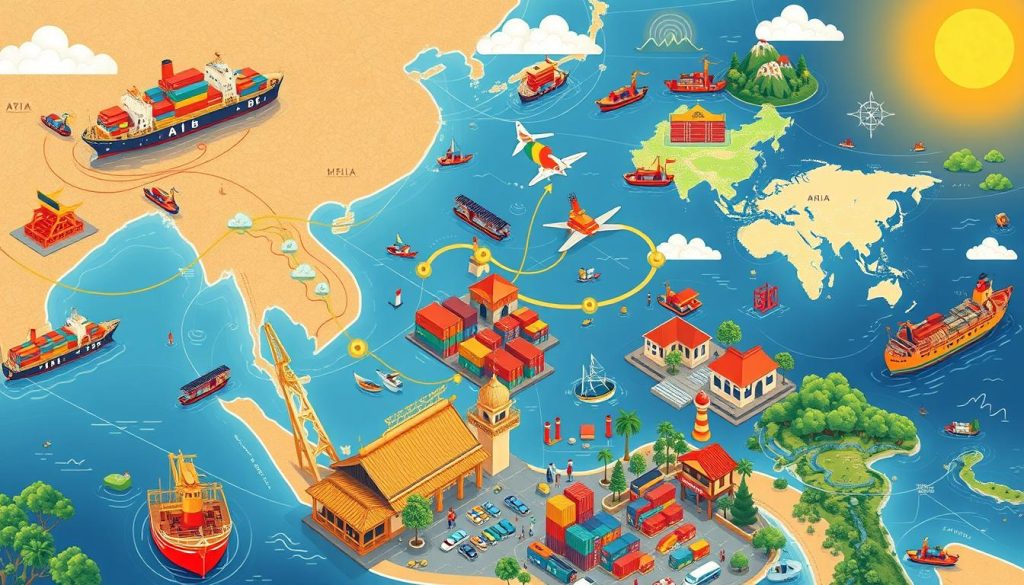
Asia’s landscape is changing fast, offering many chances for import and export. A big and growing population is key, as it boosts demand for goods. Countries like India and Indonesia have young people, making them big markets for products and services.
Technology has changed how we trade. Better logistics, online shops, and digital payments make trade easier. These tech advances are vital for Asia’s trade, making things more efficient and cheaper.
Asia’s location and transport networks help trade flow smoothly. Important shipping lanes, like the Strait of Malacca, are crucial for global trade. These advantages make trade easier and attract investment in infrastructure, helping growth.
Government policies play a big role in Asia’s trade. By cutting tariffs and opening markets, they make trading easier for everyone. ASEAN’s efforts to work together also help, making trade bigger and stronger.
Understanding Asia’s Trade Agreements and Regulations
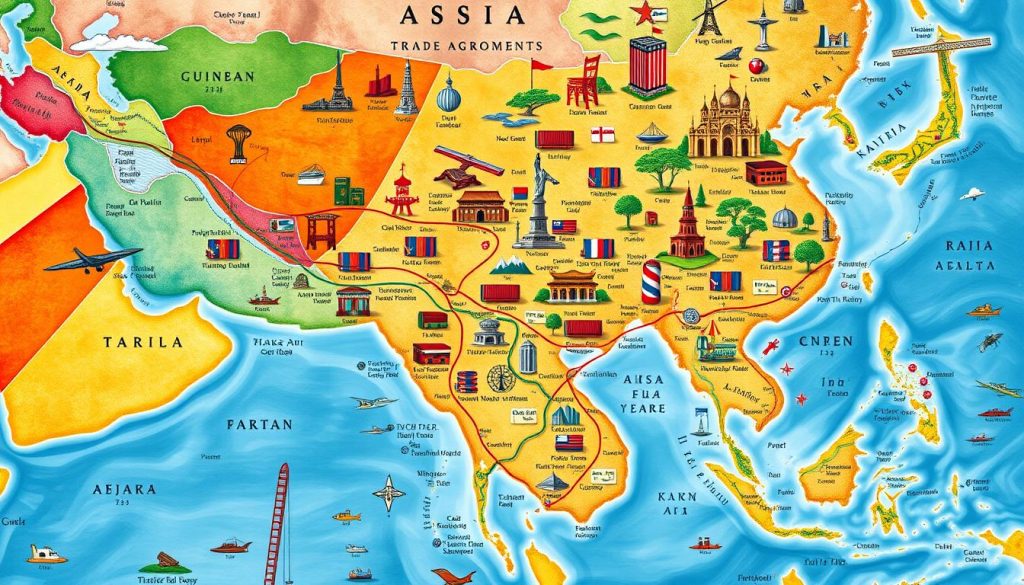
The world of importing and exporting in Asia is shaped by trade agreements. The Regional Comprehensive Economic Partnership (RCEP) and the Comprehensive and Progressive Agreement for Trans-Pacific Partnership (CPTPP) are key. They open up markets and cut tariffs, making trade easier for countries involved.
Trade rules in Asia cover customs and non-tariff barriers. Businesses must follow these rules to operate smoothly. Knowing these rules is crucial for success in the Asian market.
Understanding trade policies gives businesses an edge. Free trade agreements help companies grow by opening up new markets. These agreements affect more than just tariffs, shaping the rules of international trade.
Geographical Advantages: Logistics and Transport in Asia
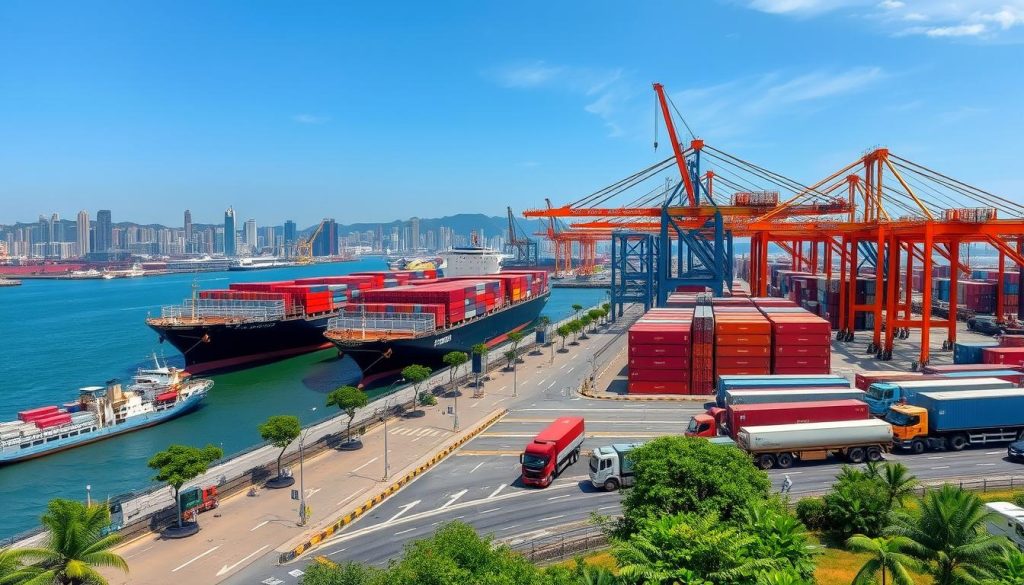
Asia is a key player in global trade, thanks to its strategic location. Major trading ports along its coastlines make moving goods efficient. Ports like Shanghai, Singapore, and Hong Kong cut shipping costs and times.
Inland, Asia’s roadways and rail systems connect remote areas to busy trade centers. This network helps meet international market demands. The focus on logistics has made Asia a key driver of economic growth.
Logistics service providers use the latest technology to boost efficiency. Automation and real-time tracking systems help avoid delays and improve service. Shipping costs in Asia are lower than elsewhere, thanks to ongoing investment in transport.
Import and Export Business Opportunities in Asia
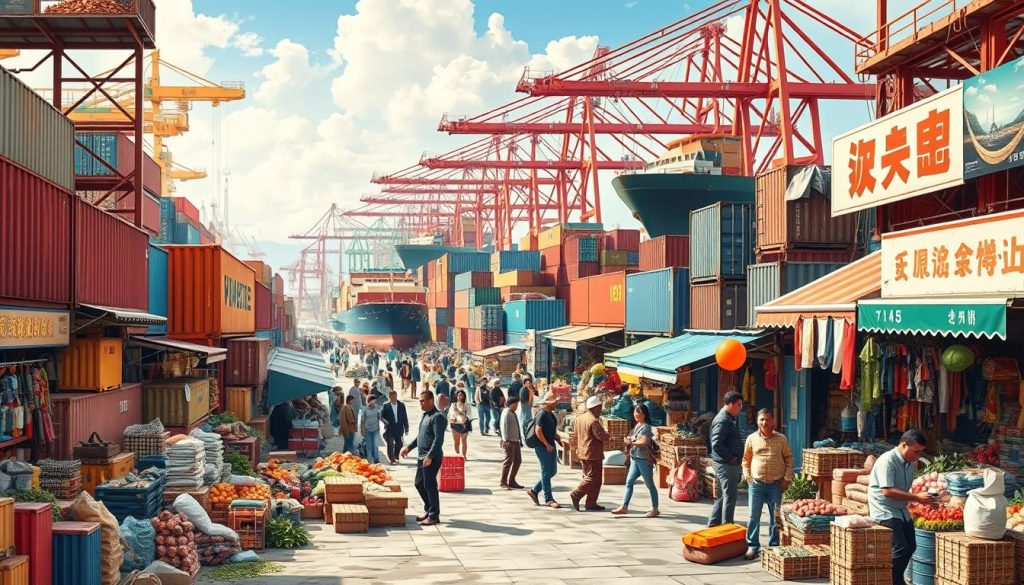
Asia is a key place for import export chances, especially in its growing markets. Countries like China and India have quickly grown their economies. This has opened up many chances for businesses wanting to grow.
These areas have big consumer bases and rising spending power. This makes them great places for both bringing in and sending out goods.
Emerging Markets: China, India, and Beyond
China and India are at the forefront of Asia’s emerging markets. They have a big need for different products. Companies from abroad can take advantage of the growing demand for quality imports.
Local businesses can also send goods to the world. New areas like technology and services add to the lively trading scene.
Sector Specific Opportunities: Electronics, Textiles, and More
In Asia, there are many chances in different sectors, like electronics and textiles. These industries meet local needs and also send goods to other countries. The electronics sector is known for its innovation and quality.
The textiles industry is famous for its skill and variety. Products from rural Asia, like food, also have big export potential.
Evaluating Market Demand for Imported and Exported Goods

Understanding market demand in Asia is key for businesses. They need to know what consumers want to offer the right products. Doing thorough market research helps companies see what people like and how tastes change.
There are many ways to check market demand, including:
- Surveys and questionnaires to get direct feedback from customers.
- Looking at trade statistics to find out what’s popular.
- Using data analytics to watch how people buy and behave.
Market demand changes a lot in different parts of Asia. Knowing these differences is crucial for making good plans. Also, who people are affects how they shop, so businesses must be flexible. Companies that use these insights will do well in the Asian market.
Understanding Cultural Differences in Business Practices
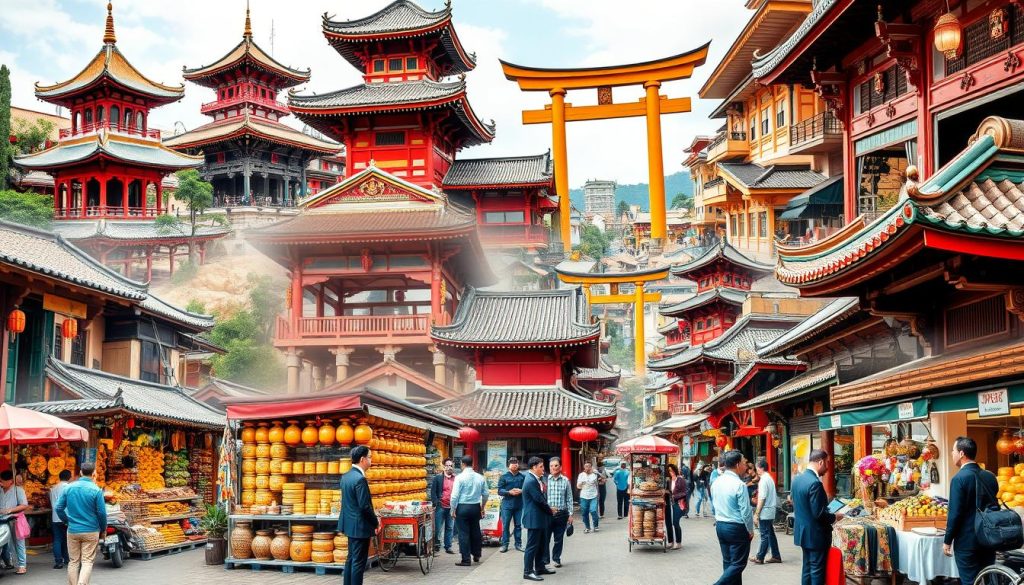
Doing business in Asia means you need to understand the cultural differences. These differences are key to successful business practices across the region. Each country has its own customs, traditions, and ways of communicating, affecting trade.
To succeed in cross-cultural trade, it’s important to know and adapt to these differences. Here are some key points to remember:
- Respect for hierarchy is often prevalent. In many Asian cultures, seniority matters greatly, and decisions may flow from the top down.
- Indirect communication is common. Establishing clear channels for expression without appearing confrontational can foster stronger relationships.
- Relationship-building is essential. Investing time in establishing trust can lead to lucrative partnerships.
By following these principles, you can improve your interactions with Asian partners. Successful cross-cultural business interactions show the benefits of being culturally sensitive. Knowing local customs and practices helps with smoother negotiations and better trade opportunities.
Establishing Relationships with Asian Suppliers and Buyers

Building strong relationships with suppliers and buyers in Asia is key for success. These ties help businesses get quality products, reliable delivery, and good prices. Trust and openness are the base of good trade partnerships.
Networking well is important for these connections. Going to industry events, seminars, and trade fairs helps meet potential partners. Talking directly builds trust and better communication.
- Prioritise clear communication to avoid misunderstandings.
- Engage in cultural sensitivity to appreciate differing business practices.
- Utilise technology for seamless communication and resource sharing.
Also, checking if a partner is reliable is crucial. Doing risk assessments and due diligence is important. Here are steps to vet a partner:
- Research the partner’s history and reputation in the market.
- Request references and check past performance in similar partnerships.
- Visit the supplier or buyer in their operational environment if possible.
Industry associations can help a lot in building strong supplier and buyer relationships in Asia. They offer resources and contacts for introductions. This can lead to great trade partnerships.
Challenges and Risks in Asia’s Import & Export Landscape
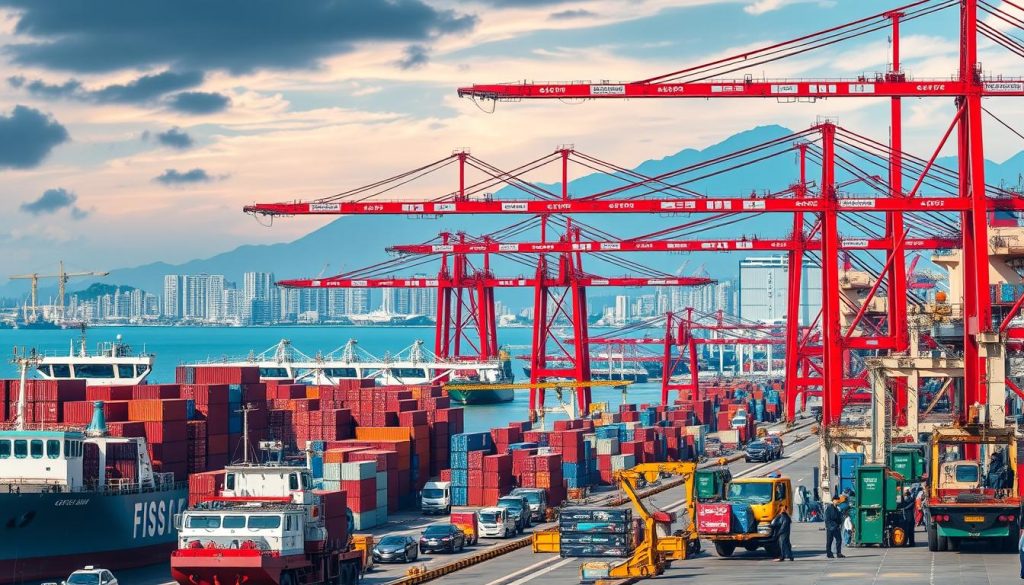
Doing business in Asia’s import and export world comes with big challenges and risks. These can really affect how well a business does. It’s key to know about political instability, economic ups and downs, and cultural differences to succeed here.
Political Instability and Economic Fluctuations
Political risks are a big deal for those exporting in Asia. Governments change fast, making trade rules and policies uncertain. Economic changes, influenced by global markets, can also mess with import and export plans. Businesses need to be ready for these changes and find ways to deal with them.
Cultural Barriers and Communication Issues
Cultural differences add to the risks in Asia’s trade world. Different ways of doing business and talking can lead to misunderstandings. It’s important to communicate clearly and understand local customs to build strong relationships.
The Role of Technology in Asia’s Trade Operations
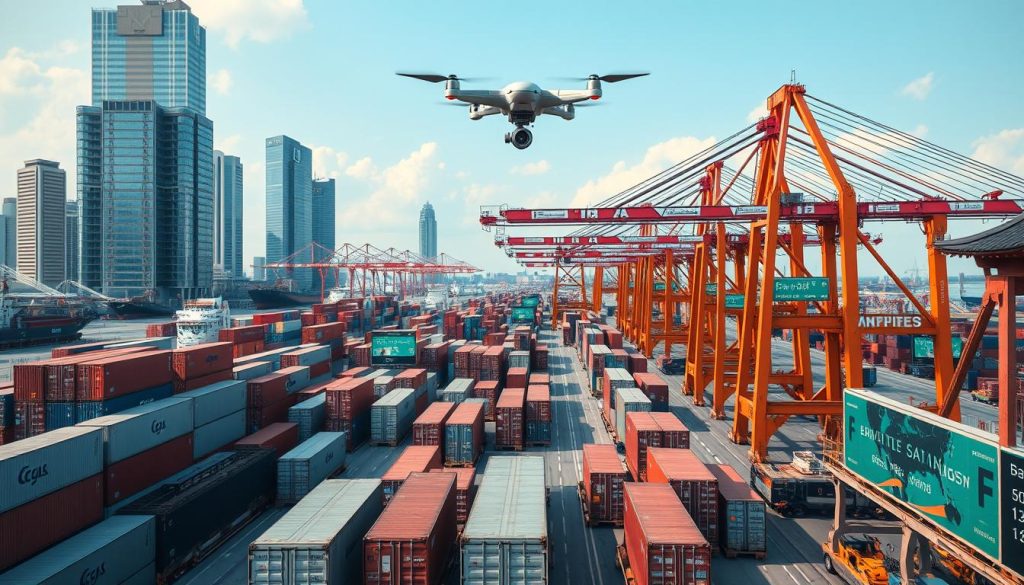
Technology has become key in Asia’s trade evolution. Digital trade has changed old ways, making things faster and more efficient. E-commerce in Asia has grown, thanks to online shops for both buyers and sellers.
New tech in logistics and supply chains is vital. Companies use AI to improve how they manage stock and fill orders. Startups in the area use tech to solve long-standing trade problems.
- Enhancing customer engagement through mobile apps and platforms.
- Utilising data analytics for market insights and consumer behaviour analysis.
- Implementing blockchain for improved transparency and traceability in transactions.
As businesses see the need to go digital, tech in trade Asia is crucial. This change brings new chances for growth. It also helps companies stay ahead in a world that’s more connected than ever.
Financing Your Import and Export Ventures in Asia
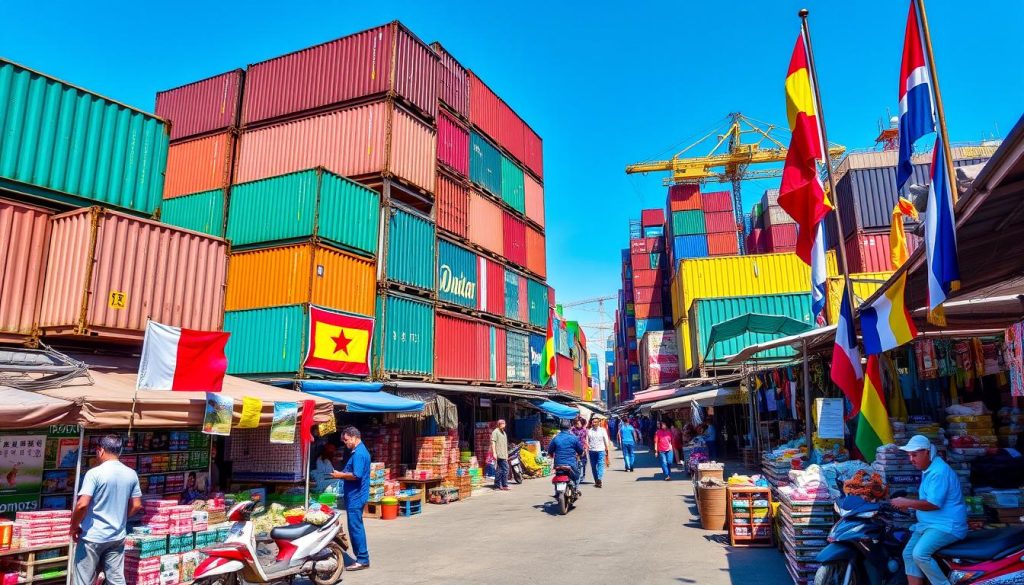
Starting import and export ventures in Asia needs a good grasp of financing options and risk management. Businesses must understand how to finance trade in Asia well. This helps them make the most of their chances while keeping risks low. It’s also key to have clear payment methods for smooth transactions and strong partnerships.
Understanding Payment Terms and Methods
Payment terms can greatly affect cash flow and the success of international deals. Here are some common payment methods:
- Letters of Credit: Offer security, ensuring payments are made once all terms are fulfilled.
- Telegraphic Transfers: Provide faster transactions for urgent payments.
- Open Account: Suitable for established relationships where trust exists.
- Cash in Advance: Preferred by sellers, reducing risk but can deter buyers.
Businesses should pick the best payment method for their needs. They need to balance trust and security.
Insurance and Risk Management Strategies
Trade insurance is crucial for protecting against unexpected issues, like shipment damage or payment defaults. Good insurance policies can save businesses from big losses. Important things to think about include:
- Marine Insurance: Covers goods in transit against loss or damage.
- Credit Insurance: Protects against buyer non-payment risks.
- Political Risk Insurance: Shields businesses from losses due to political instability.
Understanding financing trade Asia and using the right trade insurance helps businesses avoid risks. This readiness is key for lasting success in the Asian market.
Future Trends Shaping Asia’s Import and Export Business
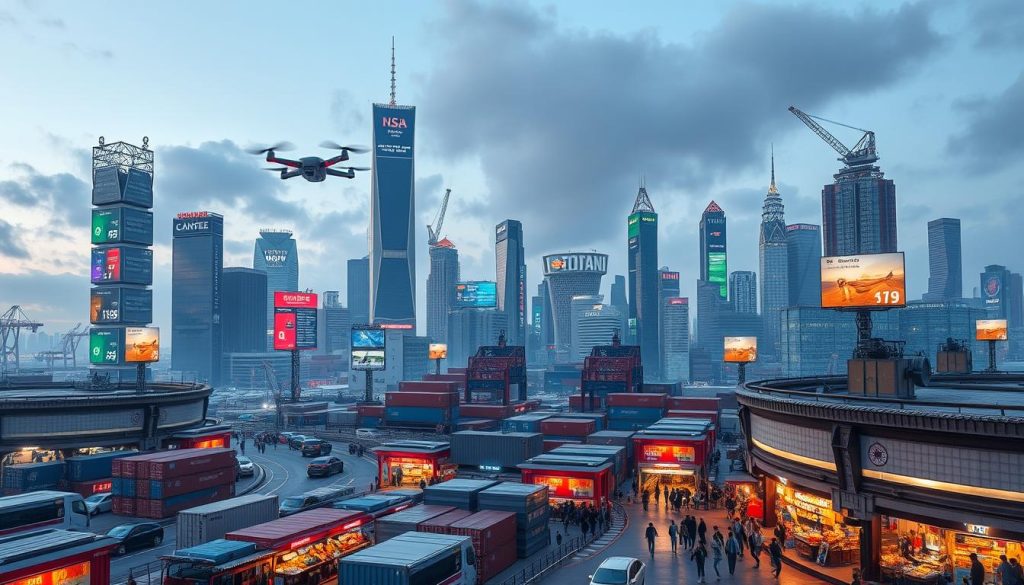
The import and export business in Asia is changing fast. Sustainability is now key, with companies focusing on eco-friendly practices. This move meets consumer needs and supports global sustainability goals.
Blockchain technology is set to improve trade by making it more transparent and secure. It helps track goods and prevent fraud, boosting trade efficiency. This could lead to more growth in the future.
Global changes are also affecting what consumers want. They now look for products that match their values. Companies must keep up with these changes to stay competitive.
Experts say digital transformation is crucial for businesses to adapt to new market needs. Using advanced technologies can make operations smoother and encourage innovation. This could give companies the edge they need in the evolving Asian trade scene.
Networking and Trade Fairs in Asia
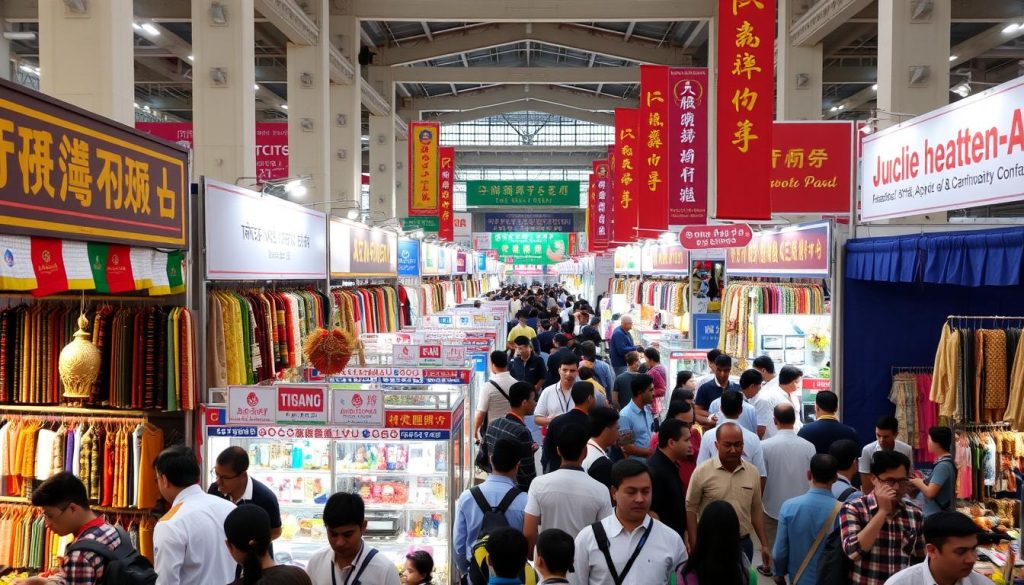
Networking and trade fairs in Asia are key for businesses wanting to grow in the region. These events are where buyers and sellers meet, creating strong business ties. The direct talks at trade fairs help build trust and understanding, essential for good trade relationships.
Going to trade fairs Asia lets companies show off their products and learn about trends. It’s a chance to meet potential partners. Here are some tips to make the most of these events:
- Do your homework on upcoming trade fairs to find the right ones for your business.
- Get ready with engaging materials that clearly show what you offer.
- Get in touch with people you met at the event soon to keep the connection alive and explore new chances.
Studies show that being at trade fairs can really help your brand get noticed and open up new markets. As Asia keeps growing as a trade centre, it’s more important than ever to take part in these events. By focusing on networking, businesses can better handle the Asian market’s challenges and opportunities.
Success Stories: Case Studies from Asian Import and Export Businesses

Asia’s trade scene is full of inspiring tales. These stories show the great business wins Asia offers to traders. They tell of companies overcoming hurdles to grow big.
Samsung Electronics is a top example. They lead in electronics with quality, innovation, and partnerships. Their focus on research keeps them ahead in a tough market.
Alibaba Group has changed global trade for businesses. They use e-commerce and tech to help small firms reach the world. This has shaped Asia’s import and export future.
These stories show what it takes to succeed. They talk about meeting market needs, building strong supply chains, and using technology. These lessons help new traders in Asia’s big trade world.
From textiles to tech, these stories show the big chances in import and export. By following these successful strategies, new businesses can find their way in Asia.
Best Practices for Sustainable Trade in Asia

Sustainable trade in Asia is becoming more important for businesses. They want to reduce their environmental impact and improve ethical standards. By using eco-friendly trade, companies meet rules and build a good brand image. It’s key to follow best practices in import and export to be sustainable.
To make sustainable trade work, businesses can do a few things:
- Ethical sourcing: Make sure materials come from suppliers who follow sustainable practices. This makes things clear.
- Reducing waste: Improve production and use recyclable materials. This helps manage waste well.
- Energy efficiency: Spend on energy-saving tech. It cuts costs and supports green trade.
- Community engagement: Work with local communities. This shows social responsibility and builds trust.
Many companies in Asia are already doing this. They show the good things about sustainable trade. These include a better brand image and stronger business performance. Following these steps helps meet global sustainability goals and stay ahead in the market.
Resources and Tools for Import and Export Professionals in Asia
Import and export in Asia can be complex. Professionals need strong trade resources to grow and improve their work. Websites like Export.gov offer insights and data on regulations and market potential. The Asia Trade Centre also provides guides on the latest trends and tools for import export ventures.
Online resources are just the start. Professional training is key for success in Asia’s trade scene. The Chartered Institute of Logistics and Transport offers courses on practical skills and strategic knowledge. These courses help professionals make informed decisions.
Using these tools and resources helps professionals succeed in Asian markets. Knowing the right trade resources in Asia opens up new opportunities. It helps in navigating the challenges of global trade.
















